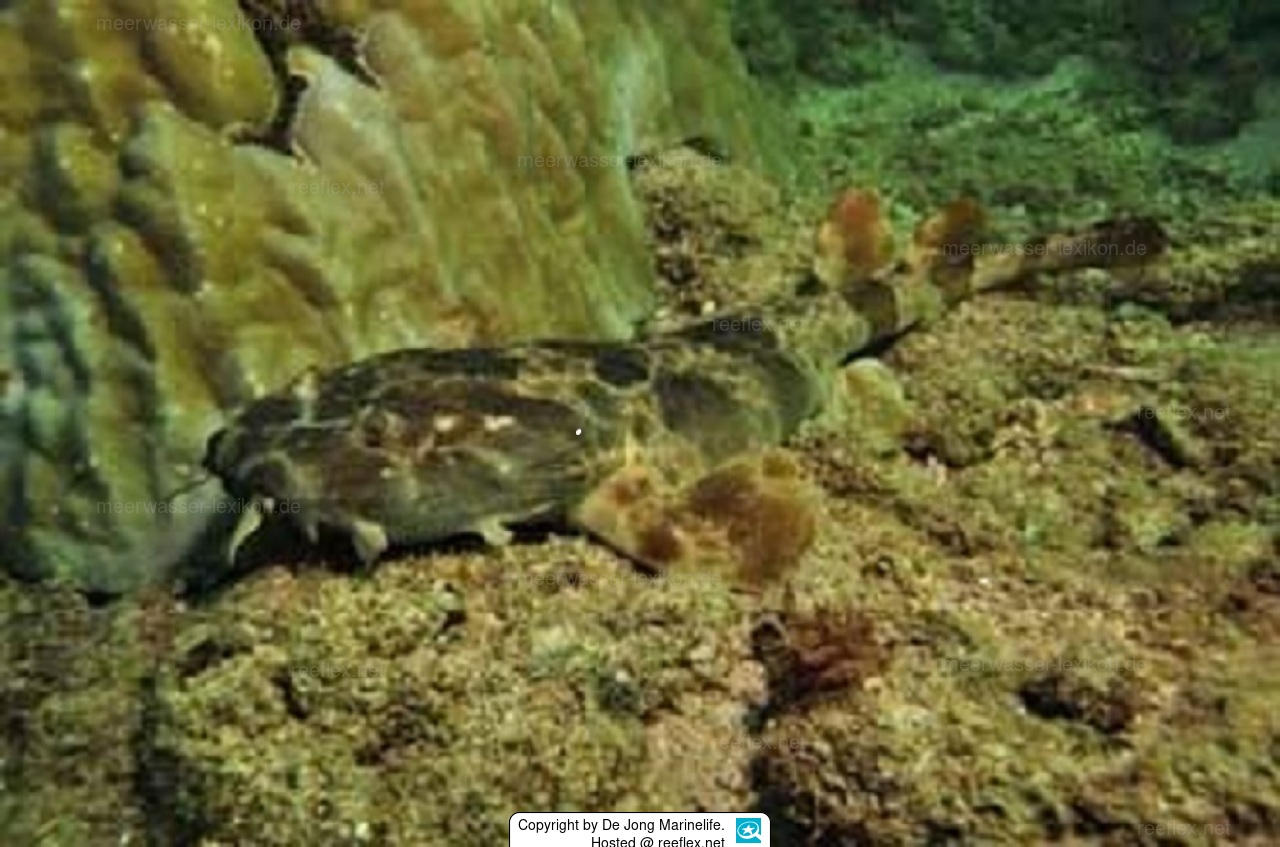Info
Orectolobus hutchinsi, commonly known as the Western Wobbegong, is a subtropical ground shark.
These fish are optimally camouflaged by their color patterns and flat-bodied, so you have to look twice before you recognize the shark as such.
This carpet shark is yellowish-brown with a dark saddle and blotchy spots, and there are seaweed-like appendages on the head that further camouflage the predator excellently and make potential prey think they are in deceptive safety.
Unlike other wobbegong shark species from the same area, the Western Wobbegong Shark has no white rings or spots on its back.
Habitat:
Orectolobus hutchinsi is a resident of sandy, rocky, and coral areas around the west coast of Australia, where water temperatures are cooler than on the east coast.
Special characteristic:
Orectolobus hutchinsi has also been observed climbing over the crests of tide pools at low tide to search for prey in larger pools, where they are thought to be protected but are unable to escape their fate.
Orectolobus hutchinsi is mainly active at night and feeds on bottom invertebrates such as crabs, lobsters, squid and fish.
In large display aquariums, it is fed enriched frozen and live foods such as crabs, shrimp, fish, and occasionally mussels.
Naming:
The species name "hutchinsi" was chosen in honor of Dr. Barry Hutchins (also a supporter of the Marine Encyclopedia), who first identified the shark in 1983, but the first description of the carpet shark was in 2006.
Caution: The fish can bite the fingers of divers and careless snorkelers or bathers, so be careful, please!
Shark bites can be quite lethal to humans, especially the 10 most dangerous shark species are considered and can launch unprovoked attacks from humans: - Great white shark - Bull shark - Tiger shark - Sand tiger shark - Blacktip shark - Bronze shark - Spinner shark - Blue shark - Hammerhead shark - Whitetip shark The bite by a shark is one of the most basic fears of humans, but the number of deaths caused by shark attacks is very low: in 2015 there were 98 attacks by sharks and in 6 cases the attack resulted in a fatal end for humans. In 2016 there were 107 attacks by sharks and in 8 cases the attack resulted in a fatal end for humans. Sources: http://hai.ch/Hai-Infos/Unfaelle/index.html http://www.focus.de/reisen/videos/auch-urlaubsorte-betroffen-schrecklicher-rekord-2016-gab-es-mehr-hai-angriffe-als-je-zuvor_id_6519581.html http://www.spiegel.de/wissenschaft/natur/hai-angriffe-erreichen-2015-rekordhoch-weiterer-anstieg-erwartet-a-1076339.html http://www.zeit.de/2016/37/haie-toetung-tierschutz-surfer
In 2022, there were a total of 108 shark attacks in the USA.
Conversely, however, 100 million sharks were killed by humans. http://www.zeit.de/2016/37/haie-toetung-tierschutz-surfer The risk of being bitten by a shark varies greatly from region to region, with most attacks occurring in Florida, Australia and South Africa. Please be careful not to go into the water with bleeding skin wounds, heed bathing warnings from the authorities and be very careful when using surfboards, as sharks can easily confuse the boards with seals and harbour seals. After shark bites, always call a doctor or / and the rescue service as soon as possible, as heavy bleeding can be life-threatening.
https://worldanimalfoundation.org/advocate/shark-attack-statistics/
These fish are optimally camouflaged by their color patterns and flat-bodied, so you have to look twice before you recognize the shark as such.
This carpet shark is yellowish-brown with a dark saddle and blotchy spots, and there are seaweed-like appendages on the head that further camouflage the predator excellently and make potential prey think they are in deceptive safety.
Unlike other wobbegong shark species from the same area, the Western Wobbegong Shark has no white rings or spots on its back.
Habitat:
Orectolobus hutchinsi is a resident of sandy, rocky, and coral areas around the west coast of Australia, where water temperatures are cooler than on the east coast.
Special characteristic:
Orectolobus hutchinsi has also been observed climbing over the crests of tide pools at low tide to search for prey in larger pools, where they are thought to be protected but are unable to escape their fate.
Orectolobus hutchinsi is mainly active at night and feeds on bottom invertebrates such as crabs, lobsters, squid and fish.
In large display aquariums, it is fed enriched frozen and live foods such as crabs, shrimp, fish, and occasionally mussels.
Naming:
The species name "hutchinsi" was chosen in honor of Dr. Barry Hutchins (also a supporter of the Marine Encyclopedia), who first identified the shark in 1983, but the first description of the carpet shark was in 2006.
Caution: The fish can bite the fingers of divers and careless snorkelers or bathers, so be careful, please!
Shark bites can be quite lethal to humans, especially the 10 most dangerous shark species are considered and can launch unprovoked attacks from humans: - Great white shark - Bull shark - Tiger shark - Sand tiger shark - Blacktip shark - Bronze shark - Spinner shark - Blue shark - Hammerhead shark - Whitetip shark The bite by a shark is one of the most basic fears of humans, but the number of deaths caused by shark attacks is very low: in 2015 there were 98 attacks by sharks and in 6 cases the attack resulted in a fatal end for humans. In 2016 there were 107 attacks by sharks and in 8 cases the attack resulted in a fatal end for humans. Sources: http://hai.ch/Hai-Infos/Unfaelle/index.html http://www.focus.de/reisen/videos/auch-urlaubsorte-betroffen-schrecklicher-rekord-2016-gab-es-mehr-hai-angriffe-als-je-zuvor_id_6519581.html http://www.spiegel.de/wissenschaft/natur/hai-angriffe-erreichen-2015-rekordhoch-weiterer-anstieg-erwartet-a-1076339.html http://www.zeit.de/2016/37/haie-toetung-tierschutz-surfer
In 2022, there were a total of 108 shark attacks in the USA.
Conversely, however, 100 million sharks were killed by humans. http://www.zeit.de/2016/37/haie-toetung-tierschutz-surfer The risk of being bitten by a shark varies greatly from region to region, with most attacks occurring in Florida, Australia and South Africa. Please be careful not to go into the water with bleeding skin wounds, heed bathing warnings from the authorities and be very careful when using surfboards, as sharks can easily confuse the boards with seals and harbour seals. After shark bites, always call a doctor or / and the rescue service as soon as possible, as heavy bleeding can be life-threatening.
https://worldanimalfoundation.org/advocate/shark-attack-statistics/







 De Jong Marinelife, Holland
De Jong Marinelife, Holland








